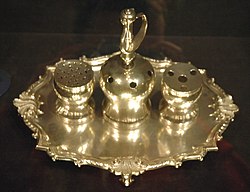| This article is part of a series on the |
| Constitution of the United States |
|---|
 |
| Preamble and Articles |
| Amendments to the Constitution |
Unratified Amendments : |
| History |
| Full text |
The Signing of the United States Constitution occurred on September 17, 1787, at Independence Hall in Philadelphia, Pennsylvania, when 39 delegates to the Constitutional Convention, representing 12 states (all but Rhode Island, which declined to send delegates), endorsed the Constitution created during the four-month-long convention. In addition to signatures, this endorsement, the Constitution's closing protocol, included a brief declaration that the delegates' work has been successfully completed and that those whose signatures appear on it subscribe to the final document. Included are, a statement pronouncing the document's adoption by the states present, a formulaic dating of its adoption, along with the signatures of those endorsing it. Additionally, the convention's secretary, William Jackson, added a note to verify four amendments made by hand to the final document, and signed the note to authenticate its validity. [1]
Contents
- Text
- Background
- About the endorsement
- About the signers
- Accompanying documents
- See also
- References
- External links
The language of the concluding endorsement, conceived by Gouverneur Morris and presented to the convention by Benjamin Franklin, was made intentionally ambiguous in hopes of winning over the votes of dissenting delegates. Advocates for the new frame of government, realizing the impending difficulty of obtaining the consent of the states needed for it to become operational, were anxious to obtain the unanimous support of the delegations from each state. It was feared that many of the delegates would refuse to give their individual assent to the Constitution. Therefore, in order that the action of the Convention would appear to be unanimous, the formula, Done in convention by the unanimous consent of the states present ... was devised.
The U.S. Constitution lays out the frame of the nation's federal government and delineates how its 3 branches (legislative, executive, and judicial) are to function. Of those who signed it, virtually every one had taken part in the American Revolution; seven had signed the Declaration of Independence, and thirty had served on active military duty. In general, they represented a cross-section of 18th-century American leadership, with individuals having experience in local or colonial and state government.
In all, twelve of the thirteen states were represented at the Constitutional Convention, with Rhode Island refusing to send delegates. Of the 74 delegates who were chosen, 55 attended and 39 signed. [2] Several attendees left before the signing ceremony, and three of the 42 who remained refused to sign. Jonathan Dayton, age 26, was the youngest signer, while Benjamin Franklin, age 81, was the oldest. [3]










